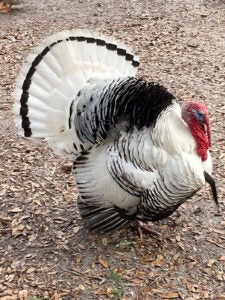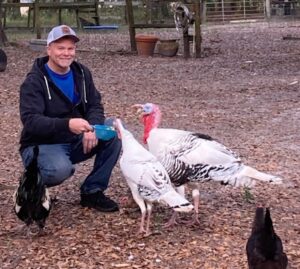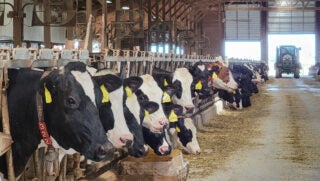The holiday season stands out for many reasons, but central to that is the tradition around food. The Thanksgiving or Christmas turkey is a ritual centerpiece that graces the table typically only once or twice a year. It punctuates a notable festivity with family and friends, so how can it possibly be even more special?
Turkey distinctly falls into the if-it-ain’t-broken-don’t-break-it category of culinary fare, as I can’t remember ever passing out on the couch, pants unbuckled, in a tryptophan-induced haze of disappointment. The subsequent days of pot pies, sandwiches and soup are equally wonderful, as the annual occasion of turkey time makes the comfort food even more comfy.
So when I learned that we were going to prepare a heritage breed turkey for Thanksgiving, my skepticism was piqued. How can something as perfect as the glossy golden brown turkey in the aroma of the Thanksgiving kitchen possibly be improved?
But to my surprise the improvement was not just a slight cut above, it was a significant leapfrog into a poultry stratosphere I never could have imagined. I’ll never go back to the perfectly acceptable market standard.
Commercial turkeys vs. heritage breed
Commercial turkeys are predominantly a variety called Broad-Breasted White. They were bred for rapid growth, transforming feed into body mass, advancing from egg to processing weight in only 18 weeks. In this short time the birds are too big to fly, as a male (tom) turkey will push a scale-busting 30 pounds (13 kg), dressing out to a grocery store weight of about 20 pounds. They are typically raised in large indoor colonies that allow controlled access to water and carefully engineered feed, while limiting factors that could threaten flock health and security.
It is a fantastic system that produces huge numbers of big, uniform, quality birds. These are most recognized by their ample white breast meat and large size on the table.
But over the last decade there is emerging interest in heritage breed turkeys. These varieties are the genetic precursors of modern commercial turkeys. Turkeys were domesticated by Maya and Aztec cultures in Mexico long before European colonization. Later, birds were moved back to Europe where additional breeding took place, and ultimately were returned to the Americas for agricultural production starting in the 1500s and continuing through to the early 1900s.
The foundational varieties differ from broad-breasted commercial turkeys in many ways, mostly in their substantially slower growth rates, smaller terminal size, a higher proportion of dark meat and a notable presence of fat under the skin and within the meat, that bastes the bird from the inside as it cooks.
But the biggest difference is taste. These slow-growing birds are to commercial turkeys what the vine ripened heirloom tomato is to the artificially induced red round thing in your produce section. The commercial standard is good — but the slowly-cultured, field-grown alternative is an improvement on the norm.
Heritage breeds taste like the turkey enjoyed by our grandparents and great grandparents before the advent of breeding for size and feed conversion at the expense of sensory quality.

Heritage origins, limitations, and advantages
Most heritage breed turkeys, such as the Narragansett and Slate varieties, were recognized as specific lines by the 1800s. Improved varieties like the Bronze and White Holland were favorites into the 1930s. Breeders sought traits like feed conversion, rapid growth and fewer pinfeathers (which are difficult to remove and add significant processing time). These eventually evolved into today’s commercial varieties.
Heritage breed turkeys are typically maintained on-farm as breeding pairs, giving rise to springtime eggs that are hatched into that year’s eventual holiday birds. Young poults quickly transition to pasture, with access to grass, field greens, and insects. The growing bird’s foraging diet is typically supplemented with standard commercial feed and special amendments like sunflower seeds.
The diversity in diet, plus the exercise gained from roaming a field, flying to roost at night, and canoodling among mating pairs, means these birds have a different experience that ultimately shapes a distinct flavor and firm texture on the table.
However, this comes with the expense of time, with turkeys reaching processing weight in 24 to 28 weeks. Their weight at processing is significantly smaller, with hens ranging from 12 to 18 pounds, toms reaching 22 to 25 pounds, depending on variety. The added time, labor, and feed costs, coupled to smaller market size, and potential loss to pasture predators are a marked disadvantage to profitable heritage turkey production.
But it is a balance against some clear advantages. Mating pairs remain productive layers for five to seven years. Their heritage genetics give them immunity to most of the diseases that could threaten modern commercial varieties. These factors, plus commanding a higher price point at market, can make heritage breed turkeys attractive to the small producer.

The consumer’s role in conservation
By purchasing a heritage breed turkey the consumer plays an important role in variety conservation.
Many of these older varieties are raised by a relatively small number of producers, with the only incentive to keeping the genetics intact is ironically the market for holiday birds. The White Holland and Beltsville Small White are considered threatened by the Livestock Conservancy, meaning fewer than 1,000 breeding birds in the United States. The iconic Narragansett was down to 87 breeding birds in 1997, reaching 2,233 in 2015, and today reports over 5,000. Rekindled interest in heritage breeds has helped improve the Royal Palm from “threatened” (fewer than 1,000) to “watch” status, a step in the right direction, ensuring their bloodlines will continue into future generations.
Conclusions
Some scoff at the notion of a “boutique” turkey, typically sold in farmers markets or specialty meat stores for $8 to $10 per pound. However, those with the courage to break from the tradition of a grocery store freezerball find they are pleasantly surprised by the newfound flavors and textures of a field-raised bird and its relatively ancient genetics. Next holiday season, find a local farmer who raises heritage breed turkeys. Try one on Thanksgiving and a commercial turkey on Christmas. Or better yet, try a standard commercial turkey cooked along side of a heritage breed. This way you can do the direct comparison and experience the advantages of both.
A standard commercial turkey is an amazing testament to breeding and genetics, and we should be grateful for their availability and affordability. However, new experiences are always welcome, and the addition of a heritage breed turkey can elevate the holiday experience, bringing in something new, while preserving the genetics that created yesteryear’s flavors.
Dr. Kevin Folta is a professor at the University of Florida. He also raises fruits, vegetables, eggs, and poultry with his wife in rural Florida, and hosts the Talking Biotech Podcast.



